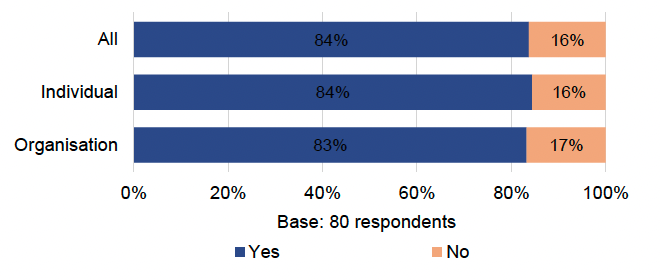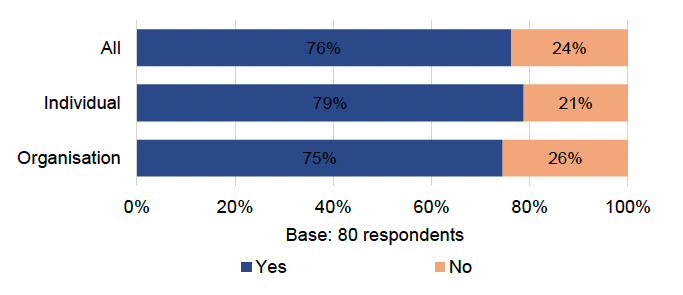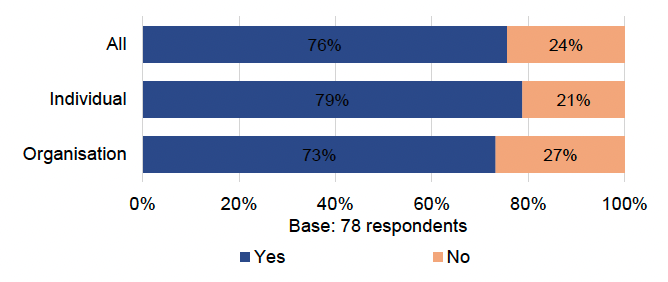Building regulations – compliance and enforcement: consultation analysis
Analysis of the building regulations compliance and enforcement consultation which ran between 11 November 2021 and 9 February 2022.
4. Enforcement
4.1 A new enforcement power for local authorities
1 The majority of respondents (84%) confirmed that they have a view on the
introduction of a new enforcement power for local authorities to take action on noncompliant work after the acceptance of the completion certificate (Figure 4.1).

2 Of 77 respondents providing supporting comments, approximately half (38) expressed general agreement, albeit 15 with caveats. Of these, nine mentioned that the introduction of such enforcement powers would have varying implications for local authorities, including the need to increase staff and/or funding resources, as well as clarifying additional responsibilities..
"Additional funding would be required for building standards [services] to ensure [they] are appropriately staffed to be able to deal with the workload associated with any additional powers." – Individual
3 Three said that the proposal ought to be applicable to certain building types and areas of work, e.g. fire safety, structural engineering etc.
"I think this is a sensible approach, but possibly only on specific building types. Do local authorities leave themselves open where they have provided a completion certificate or warrant approval only to retrospectively decide they were wrong or not suitably vigilant ahead of handover? Are there potentially any legal risks associated with this? These should be considered." – Individual
4 A total of 27 respondents expressed disagreement with the proposal. Just under half argued that such powers should not be the responsibility of local authorities, but a matter between the building owner and contractor.
"I don't feel there is any merit in this. If a completion certificate has been accepted, the verifier has done so in good faith whilst using reasonable enquiry. This should be the responsibility of the owner and their contractor/legal representatives to resolve without the use of enforcement from the local authority. Unless the building is dangerous or defective then the local authority should not be involved." – Organisation
5 A further 12 respondents commented that retrospective amendments should not be undertaken, that completion certificates should not be issued if not fulfilling all compliance requirements, and that possible changes in legislation would be needed in order to accommodate the proposal in question.
"It seems anachronistic that local authorities may need to take action on non-compliant work after the acceptance of the completion certificate. Surely, issuance or acceptance of a completion certificate should not occur until all work has been completed to an established, ratified regulatory paradigm. Legislation ought to be changed such that the issuance of a completion certificate cannot be obtained by a contractor until all criteria judged by a CPM have been certified." – Organisation
6 Three of those respondents who disagree with the proposal are of the opinion that such enforcement powers would bring a significant change to how the building standards system currently operates. For example, a verifier's involvement in a project will not necessarily end when the completion certificate has been issued with additional implications for compliance requirements and verifier workload.
7 Overall, whilst approximately half of respondents agree with the proposal, there are a number of potential implications, including increased staffing and funding required to deliver enforcement, and need for clarification around specific matters, e.g. building types this would apply to and responsibilities.
8 Additional questions raised by respondents include whose responsibility it should be to undertake retrospective amendments and whether these should be performed at all.
4.2 Level of fines for non-compliance with the building regulations
1 Approximately three quarters of respondents (76%) confirmed that they have a view on the level of fines for non-compliance with the building regulations (Figure 4.2).

2 Of 70 respondents providing supporting comments, 29 (including a roughly equal split between individuals and organisations) share the view that fines should serve as a means of encouraging compliance and deterring non-compliance. Of these, 21 argued that the fines should be proportionate to such factors as the risk they carry, project value, type of compliance requirement that has been breached, and scale of the intervention needed to fix the problem.
"The level of fines should be proportionate but also be commensurate with the risk that the non-compliance instigates. The current maximum level of fine can be equivalent to a day of Liquidated and Ascertained Damages (LADs) for major projects. The level of fine threatened needs to be sufficient to incentivise those involved to make all necessary efforts to comply. As part of the enforcement, however, there should be a requirement for the transgressor to demonstrate what steps they are taking to avoid failures to comply in future." – Organisation
3 A number of organisations (14) feel that current fines are too low.
"[We] consider that the current level of fines within legislation needs to be significantly increased to prove to be a deterrent. [We] suggest the BSD discusses the level of such fines with Scottish Government legal advisors." – Organisation
4 Eight respondents said that fines ought to represent a certain percentage of the turnover of business failing to comply with the building regulations.
"Fines should be significantly higher, perhaps relative in scale to the project cost, as the current scale of fines are out of touch with industry and in no way an effective deterrent." – Organisation
5 Five respondents argue in favour of imprisonment for serious instances of non-compliance.
"It is essential that where developers are so negligent that non-compliance results in serious loss, injury or death then the employees, contractors, directors of the companies involved [must be] held to account and in addition to fines, prison sentences imposed!" – Individual
6 Three respondents emphasised the need to educate designers and contractors on compliance, and to clearly define roles and liabilities when further developing the construction compliance process.
4.3 Level of fines for non-compliance in HRBs
1 Approximately three quarters of respondents (76%) confirmed that they have a view on the level of fines for non-compliance with HRBs (Figure 4.3).

2 Among 68 respondents providing comments in response to this question, many echoed views given in response to the preceding question. A total of 24 respondents (including a roughly equal split between individuals and organisations) reiterated the point that fines should be proportionate to the risk they carry, or type of compliance that has been breached, as well as the required intervention for fixing the problem. Added to that, 23 respondents emphasised that fines should be about encouraging better compliance.
"Fines should be reflective of the risk of the building and the risk that the non-compliance has/would put [on] the occupants." – Individual
"[We] would recommend that the level of fines should be sufficient to (a) deter applicants from non-compliance, and (b) cover the authority's enforcement costs." – Organisation
3 A total of 18 respondents emphasised in response to this question that fines should be proportionate to the project value, with eight suggesting fines are set to a certain percentage of business turnover. In addition, six respondents feel that there should not be a maximum monetary cap, especially for HRBs.
"[The maximum] fine should be unlimited but related to the overall value of the completed project. Fines must exceed the financial consequences of not progressing work in a complaint manner." – Individual
4 Six respondents mentioned again that imprisonment would be an appropriate sanction for serious consequences of non-compliance.
"The current penalty for a person found guilty of an offence on summary conviction – a fine not exceeding £5,000 – is not a meaningful deterrent to non-compliance. Especially for HRBs, financial penalties should be unlimited. In the most serious cases, criminal prosecution and, ultimately, possible imprisonment, should be an option." – Organisation
5 Three respondents again emphasised the need to educate designers and contractors on compliance, and to clearly define roles and liabilities when further developing the construction compliance process.
Contact
Email: thomson.dyer@gov.scot
There is a problem
Thanks for your feedback